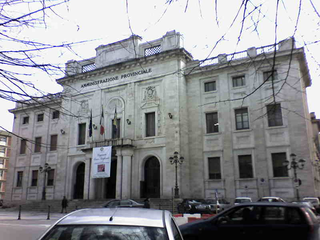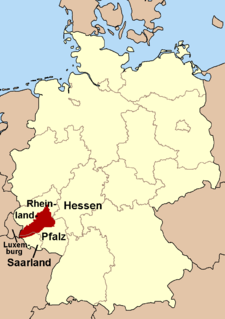
The Hunsrück is a low mountain range in Rhineland-Palatinate, Germany. It is bounded by the river valleys of the Moselle (north), the Nahe (south), and the Rhine (east). The Hunsrück is continued by the Taunus mountains on the eastern side of the Rhine. In the north behind the Moselle it is continued by the Eifel. To the south of the Nahe is the Palatinate region.
Ausona was a 4th-century BC city in the central Italian region of Latium. It was one of the three cities possessed by the tribe of the Ausones and its name seems to imply that it was their chief city or metropolis. It is only once mentioned in history: during the Second Samnite War, when—the Ausones having revolted against the Romans—all three of their cities were betrayed into the hands of the Roman consuls, and their inhabitants put to the sword without mercy. No subsequent notice is found of Ausona; but it is supposed to have been situated on the banks of the little river still called Ausente, which flows into the Liris near its mouth. The plain below the modern village of Le Fratte, near the sources of this little stream, is still known as the Piano dell'Ausente; and some remains of a Roman town have been discovered there.
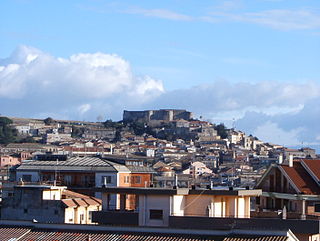
Vibo Valentia is a city and comune (municipality) in the Calabria region of southern Italy, near the Tyrrhenian Sea. It is the capital of the province of Vibo Valentia, and is an agricultural, commercial and tourist center. There are also several large manufacturing industries, including the tuna district of Maierato. Very important for the local economy is Vibo Marina's harbour.

Vuzenica is a town and a municipality in northern Slovenia. It lies on the right bank of the Drava River and extends south into the Pohorje Hills. The area was part of the traditional region of Styria. It is now included in the Carinthia Statistical Region. Vuzenica was first mentioned as a settlement in written documents dating to 1238, but archaeological evidence points to much older settlement of the area with a Roman period burial ground in the town. Of the 13th-century castle above the settlement, only parts of the walls survive.
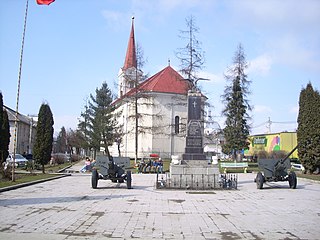
Târgu Lăpuș is a town in Maramureș County, northern Transylvania, Romania, on the river Lăpuș. In 2011, it had a population of 11,744. Of these, 86.5% were Romanians, 12.4% Hungarians and 1% Roma. 74.5% belonged to the Romanian Orthodox Church, 10.1% to the Reformed Church, 7.3% were Pentecostal, 4% Greek-Catholic and 2.7% Roman Catholic.
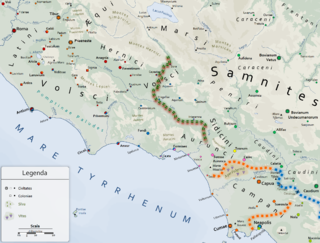
"Ausones", the original Greek form for the Latin "Aurunci," was a name applied by Greek writers to describe various Italic peoples inhabiting the southern and central regions of Italy. The term was used, specifically, to denote the particular tribe which Livy called the Aurunci, but later it was applied to all Italians, and Ausonia became a poetic term, in Greek and Latin, for Italy itself.
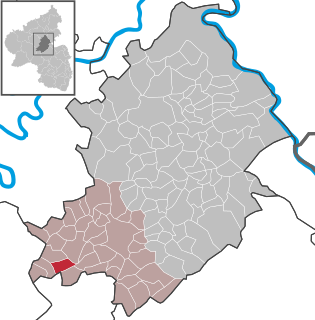
Niederweiler is an Ortsgemeinde – a municipality belonging to a Verbandsgemeinde, a kind of collective municipality – in the Rhein-Hunsrück-Kreis (district) in Rhineland-Palatinate, Germany. It belongs to the Verbandsgemeinde of Kirchberg, whose seat is in the like-named town.

Weiler bei Bingen is an Ortsgemeinde – a municipality belonging to a Verbandsgemeinde, a kind of collective municipality – in the Mainz-Bingen district in Rhineland-Palatinate, Germany. The winegrowing centre belongs to the Verbandsgemeinde of Rhein-Nahe, whose seat is in Bingen am Rhein, although that town is not within its bounds.

Dill is an Ortsgemeinde – a municipality belonging to a Verbandsgemeinde, a kind of collective municipality – in the Rhein-Hunsrück-Kreis (district) in Rhineland-Palatinate, Germany. It belongs to the Verbandsgemeinde of Kirchberg, whose seat is in the like-named town, and it is home to a castle ruin that bears the same name.

Dillendorf is an Ortsgemeinde – a municipality belonging to a Verbandsgemeinde, a kind of collective municipality – in the Rhein-Hunsrück-Kreis (district) in Rhineland-Palatinate, Germany. It belongs to the Verbandsgemeinde of Kirchberg, whose seat is in the like-named town.
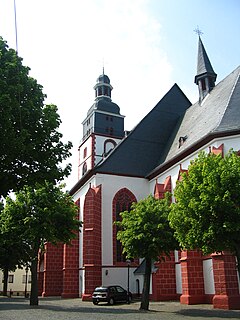
Kirchberg, the Stadt auf dem Berg, called Kerbrich in Moselle Franconian, is a town in the Rhein-Hunsrück-Kreis (district) in Rhineland-Palatinate, Germany. It is the seat of the like-named Verbandsgemeinde, to which it also belongs.

Niedersohren is an Ortsgemeinde – a municipality belonging to a Verbandsgemeinde, a kind of collective municipality – in the Rhein-Hunsrück-Kreis (district) in Rhineland-Palatinate, Germany. It belongs to the Verbandsgemeinde of Kirchberg, whose seat is in the like-named town.

Monthureux-sur-Saône is a commune in the Vosges department in Grand Est in northeastern France.

RMS Ausonia, launched in 1921, was one of Cunard's six post-World War I "A-class" ocean liners for the Canadian service.

Ausonia Montes is a mountain in the Mare Tyrrhenum quadrangle of Mars, at 25.42° south latitude and 99.04° east longitude. It is 158 kilometres (98 mi) across and was named after an albedo feature name.

Ausonia Mensa is a mensa in the Hellas quadrangle of Mars, located at 30.3° S and 262.3° W. It is 103 km across and was named after an albedo feature name. The term "Mensa" is used for a flat-topped prominence with cliff-like edges. Ausonia Mensa has many small channels. Some features look like alluvial fans. These channels add to the mass of evidence that water once flowed on Mars. Images of curved channels have been seen in images from Mars spacecraft dating back to the early seventies with the Mariner 9 orbiter.
Arbora & Ausonia was a company that dealt in the manufacturing and sale of absorbent products for the child and family hygiene, feminine hygiene and adult incontinence markets. It fully merged into Procter & Gamble in 2013.
The Sanctuary of the Madonna del Piano is a Roman Catholic church in the town of Ausonia, province of Frosinone, region of Lazio, Italy.
San Michele Arcangelo is a romanesque style, Roman Catholic church in the town of Ausonia, province of Frosinone, region of Lazio, Italy.


